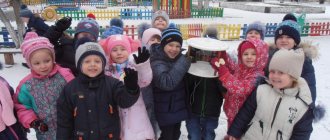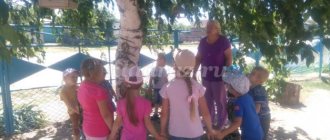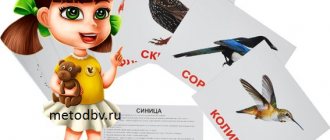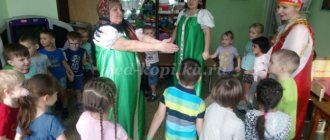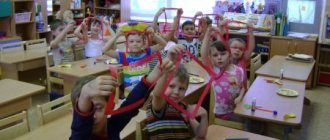Summary of a lesson in the middle group on familiarization with the outside world on the topic “Migratory Birds”
Summary of a lesson on familiarization with the outside world on the topic:
“Migratory birds” middle group
teacher: Orlova N.V.
Goals:
introduce children to migratory birds, explain why these birds are called migratory. Insert the general concept of “migratory birds” into the dictionary. Intensify the use of nouns, adjectives, and verbs in children’s speech. Develop thinking, coherent speech, auditory and visual attention, fine motor skills. To cultivate a kind, caring attitude towards feathered friends, to lay the foundations of environmental education, to expand ideas about how people care for migratory birds.
Materials and equipment:
phonogram with the noise of the forest and birdsong, pictures depicting wintering and migratory birds and their nests, material for nests: thin and thicker twigs, straws, fluff; ball.
Progress of the lesson.
Educator: Children, listen to the sound recording, what do you hear (children’s answers)
- How did you guess that this was a forest?
- What birds do you know?
— Why are some birds called wintering birds, and some migratory? Today we will get to know migratory birds. Look carefully at the pictures, what birds do you recognize here? Let me give you a little hint with the help of riddles.
Riddles about migratory birds:
- There is a palace on the pole,
There is a singer in the palace,
And his name is... (Starling)
- You will recognize him immediately:
Black-billed, black-eyed,
He walks importantly behind the plow,
She walks so importantly through the swamp!
Finds worms and beetles. (Rook)
- Comes to us with warmth,
It's been a long journey.
Sculpts a house under the window
Made from grass and clay. (Martin)
- Who's on the tree, who's on the tree?
The score is kept: “peek-a-boo, peek-a-boo?” (Cuckoo)
Educator: Well done guys, we guessed all the birds. Look, these birds fly to warmer regions in the fall and fly back to our homeland in the spring. They fly, that's why they are called? (migratory) Homeland is the place where you were born. Therefore, birds return to their homeland to build a nest and hatch chicks. The chicks are born blind, helpless, covered in down. Their parents feed them all sorts of worms, caterpillars, and flies. Over the summer, the chicks grow up and in the fall, they fly away with their parents to warmer climes. Do you know which birds have which chicks? Let's play the game “Whose Cub? Exercise “Whose cub” (with a ball) for the formation of suppletive forms of nouns. The rook has a rook and rooks. The starling has a nestling and starlings. And so on.
Educator: Guys, why do you think birds come back to us in the spring? Why do you think birds fly to warmer climates for the winter?
Educator: Look carefully at the birds, what parts of their body do they consist of? (head, body, legs, wings, beak) Now let's try to describe all our birds. Who wants to describe the rook? What is he like? Game “Describe the Bird”. (Children optionally go out and describe the birds).
Do you remember migratory birds well? We'll check this now. Come out to me and we'll play the game "Birds of Migratory"
Physical exercise: the outdoor game “Wintering and Migrating” is played to the soundtrack of cheerful music.
- Let's play. If I name a migratory bird, “fly” and “flapping your wings.” If I call you wintering, squat down and clap your hands. The children walk to the music and sing: “We walk after each other, sing together and sing merrily. You have to think, don’t yawn, just show it correctly.” (Sparrow, swallow, tit, cuckoo, crow, rook, magpie, nightingale). Take your seats. Finger gymnastics “This bird is a nightingale”
Sing along, sing along:
Ten birds are a flock. (Clap your hands)
This bird is a nightingale, (We bend the fingers on the right hand one by one, starting with the little finger)
This bird is a sparrow.
This bird is an owl, a sleepy little head.
This bird is a waxwing,
This bird is a crake,
This bird is a starling, (We bend our fingers one by one, on the left hand, starting with the little finger) A gray feather.
This one is a finch.
This one is a swift.
This one is a cheerful little siskin.
Well, this one is an evil eagle. (Hold your left thumb)
Birds, birds - go home! (We wave our arms like wings).
Educator: Guys, what are the names of bird houses? (nests). Well done, right, but what do you think, why do birds need nests? Let's try to build nests for our migratory birds. What do we need for this? (cards with images of 4 migratory birds are laid out on the tables, children choose material from a common basket: for the rook - thicker branches, for the swallow - clay and fluff, for the starling - thin twigs, and for the cuckoo ...;). Well done guys, making a nest is very hard work, but you did it, now the birds have a place to live.
Summary of the lesson: Guys, why do you think birds are needed at all? Why are birds called feathered friends?
- Why do we need birds? How are they useful to people? (Birds help people preserve their harvest, save forests from harmful insects, and delight residents with their singing)
— What do people do for birds? Now, in late autumn, how can people help birds? (Feed in winter with crumbs and plant seeds.).
— What happens if the birds disappear?
— Why do you love birds?
Tales about birds. Woodpecker.
Why is the woodpecker respected by all birds and animals? And what would happen if woodpeckers disappeared? This is talked about in the fairy tale “The Woodpecker.”
Woodpecker worker. Tales of Lake Baikal
Birds from all over the taiga flew in and began to scold the woodpecker.
The cuckoo is the angriest of all: “You give me no peace, woodpecker, you knock, you knock!”
“Your knocking makes my head hurt,” the nutcracker complains.
- Idlers, you have ready-made food: flies, mosquitoes, boogers, berries, tree buds, nuts. And I need to chisel the tree, look for beetles under the bark. I save you all, ungrateful ones, I work from morning to night!
The birds whistled, chirped, and chattered angrily: “What!” Are you saving us? - Look, what a braggart! - Let's peck him!
The din of birds was interrupted by a capercaillie - an important bird in the taiga, it does not throw words to the wind. He stamped his foot: “You shouldn’t make a fuss, the woodpecker told the truth!” It protects trees from greedy bark beetles. Without it, they would have devoured all the trees and devastated the taiga. How can we live without the taiga?.. Screamers!
The cuckoo, sitting on a tall pine tree, was the first to sing throughout the whole taiga: “Pucko-coo, woodpecker, peek-a-boo, darling!”
Behind her is a nutcracker: “I praise you, buddy.” Come on - knock, knock.
- Knock-knock - good sound! - the forest pigeon shouted loudly.
The birds surrounded the woodpecker, the violator of the forest silence, and sang in chorus.
Let's play. Mobile Russian folk game "Woodpecker"
Children stand in a circle. The child playing the role of a woodpecker stands in the middle of the circle. Children dance around the woodpecker and say the first two lines:
“A woodpecker walks by the granary,
Looking for a grain of wheat."
The woodpecker says in response:
“I’m not bored alone, I’ll take whoever I want.”
With the last word, the woodpecker quickly takes the hand of one of the guys in the circle. And the children must quickly stand in pairs. The child left without a mate becomes a woodpecker in the next game.

